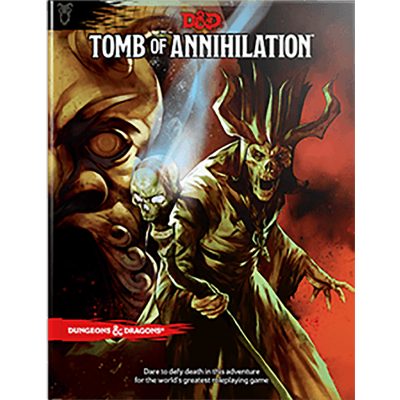Review: Dungeons and Dragons – Tomb of Annihilation
Product Reviews
Wizards of the Coast
Tomb of Annihilation
dnd.wizards.com
Death has never been that big of a problem in the Forgotten Realms. If shit goes south during a dungeon raid and a party member gets themselves riddled with arrows, fatally poisoned or burned to death, it’s a minor inconvenience to get them revived. In Tomb of Annihilation, the grim reaper is not so easily cheated. Thanks to an artifact called the Soulmonger, a debilitating disease known as the Deathcurse has made it impossible for the dearly departed to be revived. To make things worse, those who have died and come back are doomed to having their souls slowly sucked from their bodies over a period of months until they eventually die for good. With permadeath lingering over every encounter, Tomb of Annihilation is the type of campaign that can bring out the best—or worst—in a dungeon master.
The narrative of the campaign begins with the group being hired by Syndra Silvane, a wealthy former adventurer who is afflicted with the Deathcurse. Her sources have tracked the Soulmonger to the ancient jungles of Chult, a setting that hasn’t been used for an officially sanctioned Dungeons and Dragons campaign since 1993’s The Jungles of Chult. With nothing but a rudimentary map and a slap on the ass, the players essentially get turned loose in a dinosaur-and-zombie-infested jungle hell.

At its core, Tomb of Annihilation follows a classic quest structure. The party has an objective, a deadline—Silvane is slowly dying, so each day the party spends exploring brings her closer do permanent death—and a sprawling expanse of dangerous wilderness stands in their way. Like any good campaign, Tomb of Annihilation is also strewn with sidequests that do a great job of providing interesting exposition about Chult and its history. The party may not get a chance to explore everything, but each landmark, ruin and cavern adds a lot of texture to the main narrative.
Despite its classic structure, Tomb of Annihilation offers a few standout mechanics that make it unique. First and foremost, the appendix includes two new character backgrounds—archaeologist and anthropologist—which lend themselves well to players who would like to role-play a character like Indiana Jones or Lara Croft, joining a jungle expedition in search of fortune and glory. The creature appendix adds a fascinating new supplement to the Monster Manual—murderous plants, mischievous jungle spirits and undead dinosaurs are just a few Chultan terrors—and including players in a high-stakes dinosaur race through the streets of Chult’s largest port city provides a reprieve from hacking and slashing.
I’ve never been a huge fan of running a game where the players have to keep track of their food and water, but Tomb of Annihilation is much more fun when the DM takes a Werner Herzog approach—exploring the jungle in and of itself needs to feel like it’s pushing the players’ bodies to the limit. The campaign offers plenty of resources for DMs who want to be a bit more punishing to their players. First of all, navigation checks need to be made daily to see if the party is actually going the right way. A bad roll means that the team could wander into a deadly cluster of man-eating plants, or become ambushed by a raiding party of poisonous frog people called Grungs. This was one of my favorite parts of the adventure—DMs who enjoy playing by the seat of their pants will get a kick out of either making up encounters on the spot or using the campaign’s handy encounter generator. Tomb of Annihilation is also one of the more handout-heavy campaigns that I’ve come across. The later chapters of the campaign hinge tightly on the fulcrum of puzzle-solving and critical thinking, so the appendix is packed with handouts that conjure up the flavor of ancient inscriptions and puzzle pieces.
When stacked up against Storm King’s Thunder, Tomb of Annihilation feels blessedly streamlined and adventure-focused. There are no politics to navigate, no sieges to weather—it’s just a deep dive into an unforgiving wilderness to destroy an artifact that can’t be destroyed. Its well-organized library of destinations and its exhaustive supply of random jungle encounters make this a great campaign for a first-time DM to pick up, but it also has plenty of room for veteran DMs to mix things up a bit. –Alex Springer

